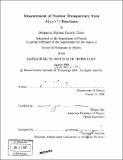Measurement of nuclear transparency from A(e,e'[pi]⁺) reactions
Author(s)
Clasie, Benjamin Michael Patrick
DownloadFull printable version (7.418Mb)
Other Contributors
Massachusetts Institute of Technology. Dept. of Physics.
Advisor
Haiyan Gao.
Terms of use
Metadata
Show full item recordAbstract
The color transparency phenomenon refers to the suppression of final-state interactions of a hadron propagating through the nuclear medium at large momentum transfer when the hadron is produced with small transverse size. The pion electroproduction cross section from 1H, 2H,12C, 63Cu and 197Au targets from Q2 = 1.1 to 4.8 (GeV/c)2 was measured in Jefferson Laboratory Experiment E01-107. The nuclear transparency was formed by the ratio of ([sigma]A/[sigma]H) from the data and ([sigma]A/[sigma]H) from a model of electroproduction from nuclei that does not include [pi]-N final state interactions. A signature of color transparency is the enhancement of the nuclear transparency at large Q2 compared with predictions based on Glauber multiple scattering theory. This experiment represents the first nuclear transparency data from (e,e'[pi]+) reactions.
Description
Thesis (Ph. D.)--Massachusetts Institute of Technology, Dept. of Physics, 2006. In title on t.p., "[pi]" appears as the lower-case Greek letter. Includes bibliographical references (p. 161-165).
Date issued
2006Department
Massachusetts Institute of Technology. Department of PhysicsPublisher
Massachusetts Institute of Technology
Keywords
Physics.